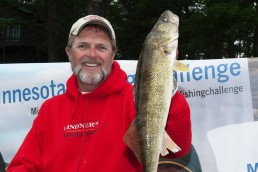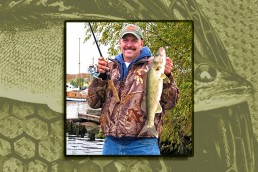Catching Walleyes in a ‘Snap’
SHARE THIS POST
Trolling patterns that cover water and break down big locations with crankbaits often seem to dominate the walleye scene come midsummer. As fish pull out over deep contours or basins, and in some cases suspend over open water, nothing beats a crankbait for eliminating water.
Part of what makes trolling crankbaits so effective as we move toward the heart of the summer is that a crankbait is the fastest presentation you have. With speeds ranging from 2 to 3 mph, you can simply cover more water. Once the water warms up beyond 70 degrees, you can often get away with faster trolling speeds that surpass 2 mph. My recommendation is to troll as fast as the fish will let you get away with because catching them is often simply eliminating water (you eliminate more water when you can troll faster) and running a lure in front of as many fish as possible.
Over the past 10 years, one hot trend on many inland lakes and reservoirs has been running smaller, hard, vibration lures like Salmo Hornets behind leadcore line. Over the past five years, we have also seen another trend gain some serious momentum, and that is using big snap weights. In fact, using snap weights as large as 4 or 5 ounces that get out quickly and fish closer to the boat are actually starting to replace leadcore, which has been a staple for walleye anglers.
Now snap weights have been a part of the walleye-trolling routine for some time, but many of the old snap weight methods mirrored the Great Lakes’ methods and origins for presentations. That is, clips with varying weights that ranged from 1/2- to 4-ounce sizes, where anglers employed a 50/50 rule where either the crankbait or spinner harness was always the same (50 feet) and anglers changed the snap weight size to vary running depths and typically ran several lines out to the sides of the boat with inline planer boards.
With offshore-trolling roots from Great Lakes fisheries, this snap weight method has morphed into something completely different as you move west. The 4- to 5-ounce snap weights are often fished 6 to 10 feet in front of the lure, and these heavy weights can often be fished right below the boat. The setup time with this heavier system is dramatically faster, with no waiting. The speed of this setup is one of the greatest advantages over traditional leadcore.
Because of the closer proximity to the boat combined with this quicker deployment time, we can often have an easier time following tight outside and inside cuts as we follow a contour. And the snap weight is never far from the transducer. While snap weights will lift and fall as boat speed changes, the lift and fall of such a heavy snap weight is not as dramatic as on smaller snap weights or leadcore. Big waves or outside and inside curves will cause the lure and snap weight to surge and stall, but speed will do little to adjust to changes in running depth.
Because of these characteristics, these heavier snap weight systems shine whenever you need to follow a specific depth range that is beyond 20 feet of water where the boat has to follow the contour. Because of the speed of deployment, anglers can often fish tighter areas than you would typically dare to use leadcore.
Fishing these magnum snap weights can sometimes feel more like bottom-bouncer and spinner presentations than traditional trolling. Drop the snap weight down to the bottom and reel up until the snap weight isn’t touching the bottom and the crankbait is running clean and free.
Are you enjoying this post?
You can be among the first to get the latest info on where to go, what to use and how to use it!
Sometimes referred to as a “poor man’s downrigger,” you can effectively use snap weights to efficiently fish down to 60 feet of water. You are essentially putting cranks right behind and below the boat and can deploy them extremely quickly. Another advantage to using snap weights is the simple efficiency with which you are fishing at closer to the boat when you don’t have as much line to reel up when catching a fish. If you can reel a fish up on 50 feet of line, you will lose fewer fish than if you have to reel up a fish on 100 feet of line.
Typically, extremely clear water—like you find on the Great Lakes fisheries or bodies of water with zebra mussels—require much longer leaders between the lure and the snap weight, but most inland waters will suffice with a lead that is the length of the rod. Seven to 10 feet of line will work, and the shorter lead between the weight and lure sure makes netting fish easier without having to remove the snap weight.
Most anglers will use a 10- or 14-pound braid for the main line for added sensitivity. Even with the snap weight, you can still usually tell if the lure is fouled or out of tune. Line-counter reels are necessary when paired up with a trolling rod like the Jason Mitchell Pro Walleye Series Great Lakes Trolling Rod, which is an all-purpose trolling rod for running boards, snap weights and leadcore.
Of course, with your trolling spread you can mix up some snap weights with leadcore, wire, Dipsy Divers or flatlines. Most in-line planer boards will handle up to 3 ounces of lead, depending on the amount of line, speed and height of the waves. In my opinion, snap weights really begin to shine in July and now in August, when water continues to warm up and the pendulum action you get with changes in speed often trigger fish. Leadcore can often shine on the off-days, whereas snap weights can kick in when the fish are on.
In states where multiple rods can be used, anglers often run smaller shad-profiled baits off snap weights while long-lining deep divers farther out the back of the boat to stagger the lures. One of the most impressive deep-diving crankbaits on the scene right now for long-lining in deep water is the Salmo Free Diver. This lure will reach about 40 feet of water without adding weight and has a loud rattle. Because of its exceptional dive curve, the Free Diver is a nice complement to snap weights when sneaking an extra line or two behind the boat.
This summer, make sure to incorporate snap weights into your walleye-trolling arsenal. Snap weights have an effective way of simplifying trolling in that you drop a heavy weight behind the boat and reel up the lure off the bottom and into a strike zone.
Jason Mitchell is a top walleye guide on Devils Lake, N.D. He is the host for the outdoor program, “Jason Mitchell Outdoors.” Visit jasonmitchelloutdoors.com for more.
MWO
SHARE THIS POST
Did you enjoy this post?
You can be among the first to get the latest info on where to go, what to use and how to use it!
Jason Mitchell
Jason Mitchell was a top walleye guide on Devils Lake, N.D. for nearly 20 years. Today, Mitchell produces the Jason Mitchell Outdoors TV program. Visit jasonmitchelloutdoors.com for more.



